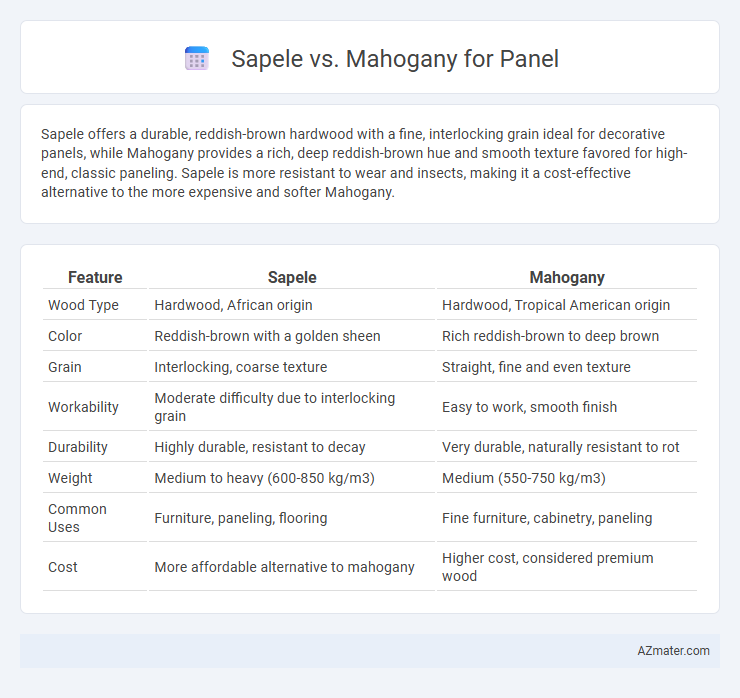Sapele offers a durable, reddish-brown hardwood with a fine, interlocking grain ideal for decorative panels, while Mahogany provides a rich, deep reddish-brown hue and smooth texture favored for high-end, classic paneling. Sapele is more resistant to wear and insects, making it a cost-effective alternative to the more expensive and softer Mahogany.
Table of Comparison
| Feature | Sapele | Mahogany |
|---|---|---|
| Wood Type | Hardwood, African origin | Hardwood, Tropical American origin |
| Color | Reddish-brown with a golden sheen | Rich reddish-brown to deep brown |
| Grain | Interlocking, coarse texture | Straight, fine and even texture |
| Workability | Moderate difficulty due to interlocking grain | Easy to work, smooth finish |
| Durability | Highly durable, resistant to decay | Very durable, naturally resistant to rot |
| Weight | Medium to heavy (600-850 kg/m3) | Medium (550-750 kg/m3) |
| Common Uses | Furniture, paneling, flooring | Fine furniture, cabinetry, paneling |
| Cost | More affordable alternative to mahogany | Higher cost, considered premium wood |
Introduction: Sapele vs Mahogany for Panel Applications
Sapele wood offers a rich, reddish-brown hue with a fine, interlocking grain, making it a popular choice for decorative panel applications due to its durability and resistance to wear. Mahogany, prized for its deep, warm color and straight grain, provides excellent workability and a smooth finish, ideal for high-end paneling in furniture and interiors. Both woods possess natural stability and resistance to decay, but Sapele tends to be more affordable while Mahogany is often considered a premium option for luxury panel designs.
Wood Origins and Botanical Differences
Sapele originates from West Africa, primarily found in countries like Nigeria and Ivory Coast, belonging to the Meliaceae family with the scientific name Entandrophragma cylindricum. Mahogany, especially genuine Honduran mahogany, is native to Central America, classified under the genus Swietenia, and is known for its durable, straight-grained wood from Swietenia macrophylla. The botanical difference lies in their genus and species, impacting their grain patterns, color variations, and durability characteristics in wood panel applications.
Appearance and Grain Patterns
Sapele features a rich reddish-brown color with interlocking grain, creating a striking ribbon-like pattern that enhances panel aesthetics. Mahogany displays a deep, warm reddish-brown tone with consistent straight grain, offering a smoother and more uniform panel surface. The intricate grain of Sapele adds texture and visual interest, while Mahogany's classic grain pattern delivers timeless elegance in panel applications.
Color Variations and Aging
Sapele wood features a rich reddish-brown color with subtle golden highlights that deepen into a dark, chocolatey hue over time, providing a warm and elegant look for panels. Mahogany exhibits a more consistent reddish-brown tone with occasional pink or purple undertones, which typically darkens to a deeper, rich mahogany shade as it ages, enhancing its classic appeal. Both woods develop a beautiful patina with exposure to light, but Sapele's color evolves more dramatically compared to the more stable and uniform aging process of Mahogany.
Durability and Hardness Comparison
Sapele wood offers notable durability with a Janka hardness rating of approximately 1,410 lbf, making it resistant to wear and impact, ideal for long-lasting panel applications. Mahogany, depending on the species, generally has a slightly lower Janka hardness rating around 800 to 900 lbf, which provides moderate durability but is softer compared to Sapele. For panel installations requiring higher resistance to dents and abrasions, Sapele's superior hardness and dense grain structure make it a more robust choice than Mahogany.
Workability and Ease of Finishing
Sapele offers excellent workability with a fine, interlocked grain that machines smoothly and shapes well, making it a preferred choice for detailed paneling. Mahogany is also highly workable, known for its straight grain and uniform texture, which allows for easy cutting and sanding with minimal tear-out. Both woods finish beautifully, but Mahogany tends to absorb stains more evenly, resulting in a richer, deeper color on panels compared to the natural luster and reddish-brown hue of Sapele.
Acoustic Properties and Sound Performance
Sapele offers a warm, balanced tonal quality with good midrange resonance, making it suitable for musical instruments and acoustic panels where clarity and warmth are desired. Mahogany delivers a richer, deeper sound with enhanced bass response and sustained resonance, often preferred for high-quality acoustic panels and guitars requiring fuller, more resonant tones. Both woods provide excellent acoustic properties, but Sapele's harder density favors brighter articulation while Mahogany's softer grain supports richer, warmer sound performance.
Cost and Availability in the Market
Sapele wood typically costs less than true Mahogany, making it a more budget-friendly option for panels while maintaining similar aesthetic qualities. Mahogany's price is higher due to its scarce availability and demand for premium furniture and veneers, which affects overall market costs. Sapele is more readily available in the market, sourced primarily from West Africa, whereas genuine Mahogany is limited and often comes from Central and South American regions, impacting project timelines and procurement.
Environmental Impact and Sustainability
Sapele and mahogany differ significantly in their environmental impact and sustainability, with sapele being a more eco-friendly choice due to its faster growth rate and greater availability from sustainably managed African forests. Mahogany, especially genuine species like Swietenia macrophylla, faces challenges from overharvesting and illegal logging, leading to stricter trade regulations and higher environmental concerns. Opting for sapele panels supports responsible forestry practices and helps reduce the ecological footprint compared to the often more threatened mahogany varieties.
Choosing the Right Wood for Your Panel Project
Sapele offers a rich reddish-brown color with fine, interlocked grain patterns making it durable and resistant to warping, ideal for high-quality paneling. Mahogany provides excellent workability, a smooth finish, and deep reddish-brown hues that enhance aesthetic appeal in classic and elegant panel designs. When choosing wood for panels, consider Sapele for its robust strength and moisture resistance, while Mahogany suits projects where fine craftsmanship and timeless beauty are paramount.

Infographic: Sapele vs Mahogany for Panel
 azmater.com
azmater.com